Are you looking for nutritious and flavor-packed food options to stock up in your kitchen cabinet? You can learn how to dehydrate blueberries so you can enjoy a year’s worth of supply.
As a seasonal berry, you can’t always enjoy fresh blueberries all year round. But, there is a way to enjoy these berries all year round, without losing the nutrients and fresh flavors they pack at any time of the year, all you have to do is dry them.

Blueberries are pretty easy to dehydrate and use in a variety of recipes or eat individually as snacks. These fruits feature a small and uniform size, which means they dry pretty easily and quite evenly.
However, investing in store-bought blueberries can be costly and may not always offer the same explosive flavor profile you would enjoy from home-dried ones.
With the right technique, you can very easily dry your own blueberries using your dehydrator at home. The best part is you needn’t add any additives or preservatives.
Yet, you will enjoy the best flavors, nutrient-dense, and long-lasting snacks. We’ve shared a detailed foolproof guide on how to dehydrate blueberries from the comfort of your home.
Dehydrated Blueberries Benefits & Uses
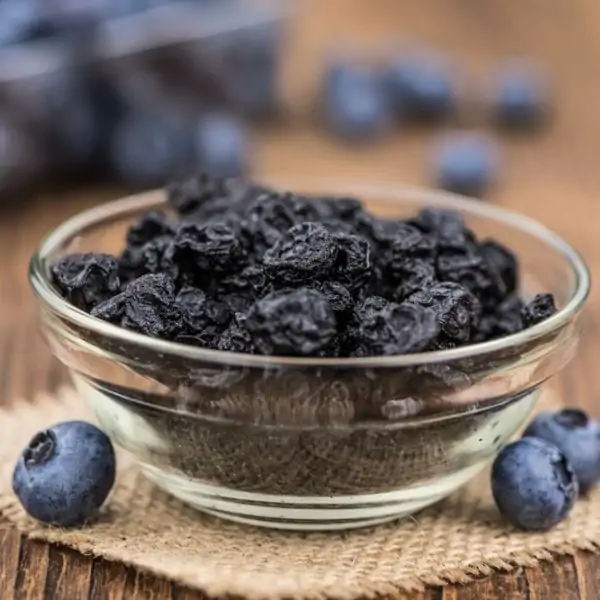
Fresh blueberries pack a nutrient-rich composition. Drying them doesn’t rob them of the nutrients.
In fact, there aren’t any nutritional differences between fresh and dried blueberries. In addition to their low sodium levels, dried blueberries are rich in vitamin K, and antioxidants, and contain zero cholesterol.
Incorporating blueberries in your daily diet gives you enough daily recommended value of vitamin K to help the blood clot properly and support healthy bones, as it helps the body use up calcium sufficiently. Dried blueberries also pack antioxidants, thanks to their rich vitamin C content.
The antioxidants allow wounds to heal quire, promote cardiovascular health, repair teeth and bones, and even facilitate collagen production, which is vital for the skin, blood vessels, and tendons. Using dried blueberries is also a safe and healthy way to replace sugar in your recipes, especially if you suffer from type 2 diabetes.
Dried blueberries have a variety of uses. You can eat them on their own as snacks or add them to different recipes.
You can rehydrate them and add them to your home baking. Alternatively, you can add them to your oatmeal and trail mix or use them to make homemade tea blends and salad dressings.
Step-By-Step Guidelines on How to Dehydrate Blueberries
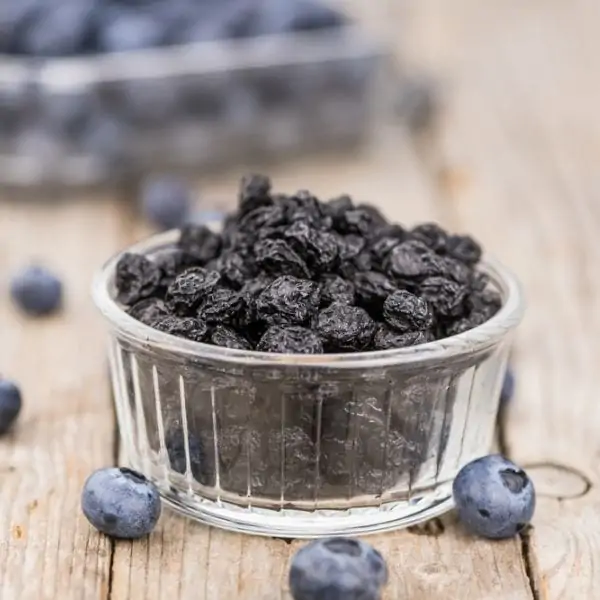
Dehydrating blueberries doesn’t involve the use of any sweeteners or preservatives. Blueberries are ultra-sweet on their own so they don’t need any extra sweeteners.
On the other hand, since drying them pulls out all the moisture, they don’t really need additional preservatives to prolong their shelf life.
Since you won’t add anything extra, you should expect your dried blueberries to become firmer and drier like raisins and unlike store-bought ones. The difference is that the less healthy store-bought dried blueberries typically contain cane sugar, sulfites, and oil to keep them chewy and soft.
You also want to choose the right, in-season blueberries to ensure you harness the best flavors since you will not add any flavorings during the drying process. Choose purple-blue to blue-black berries with a sweet, plump, and smooth-skinned finish.
Here’s how to dry your blueberries using a dehydrator at home:
Duration
Prep time: 15 minutes to 1 hour
Dehydrating time: 8 hours
Tools Needed
- Metal strainer/ colander
- Vinegar
- Large pot
- Ice and water in a large pot (ice bath for blanching)
- Parchment or baking paper
- Mesh trays
- Dehydrator
Ingredients
- Water for blanching
- Fresh or frozen blueberries
Step 1: Wash and Prepare the Blueberries
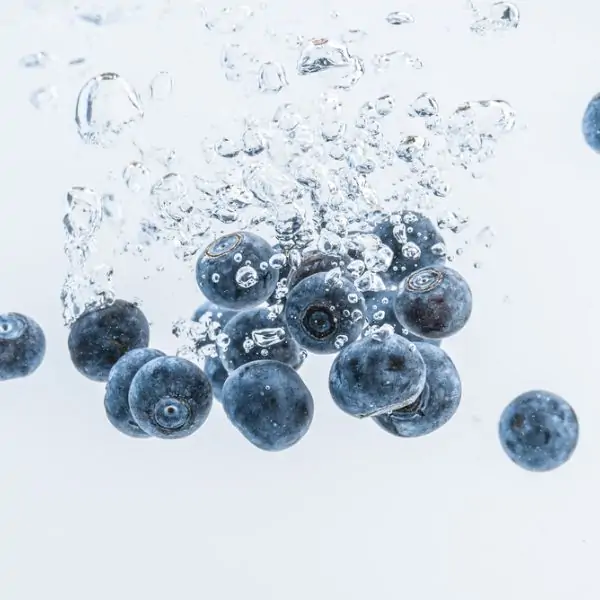
Use a metal strainer or colander to wash blueberries under running sink water. Pick out any unwanted berries (rotten or overly ripened) and debris.
Soak the berries you want in a one-part vinegar one-part water batch for a few minutes and rinse again under running water to kill any unwanted microbes.
Step 2: Break the Blueberry skin
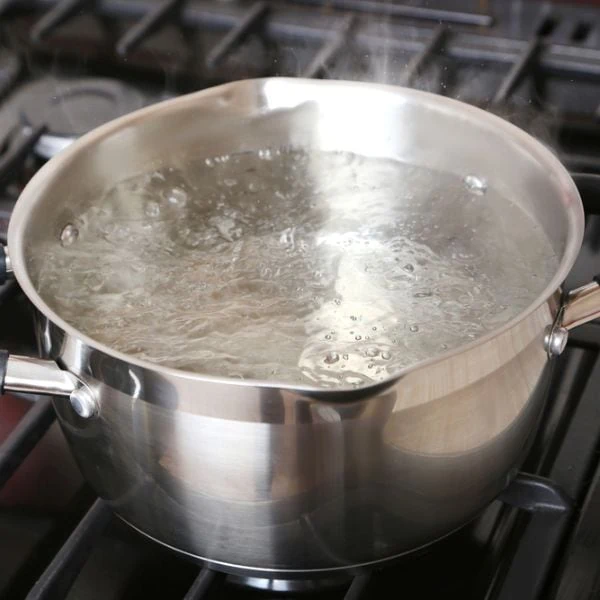
The next step is to break the blueberry skin to shorten your drying time and allow the blueberries to become softer after being dehydrated. This makes them better tasting when you use them as toppings for your cereal or in your trail mix.
Option 1: The first option for breaking the skin is blanching the blueberries. To do so, fill a large pot with water and bring it to a boil.
Next, place the berries into a mesh strainer or metal colander and dip them into boiling water for about 30 seconds to check them. Immediately remove the berries from the hot water and place them into the ice water bath to stop them from cooking further.
As mentioned above, blueberries feature a tough skin designed to naturally hold in moisture. This blanching process opens up their skin by scarring it, allowing moisture to escape.
During the dehydration process, the blueberries will be able to lose enough moisture and water content to dry up sufficiently. Blanching also helps to make the skin softer before dehydration.
Option 2: Use a skewer, toothpick, fork, or knife tip to poke holes into each blueberry.
Option 3: Cut each blueberry in half using a sharp knife
Option 4: Process the blueberries in a blender or food processor to produce small bits or puree. But, this method only works if you want to ultimately process your berries into fruit leather or powder.
Option 5: Freeze the berries for a day or two. Frozen blueberries don’t require blanching or poking holes. This is because the freezing process bursts the skin, eliminating the need for blanching. Simply remove the berries from the freezer and let them thaw.
Step 3: Arrange the Blueberries in the Dehydrator
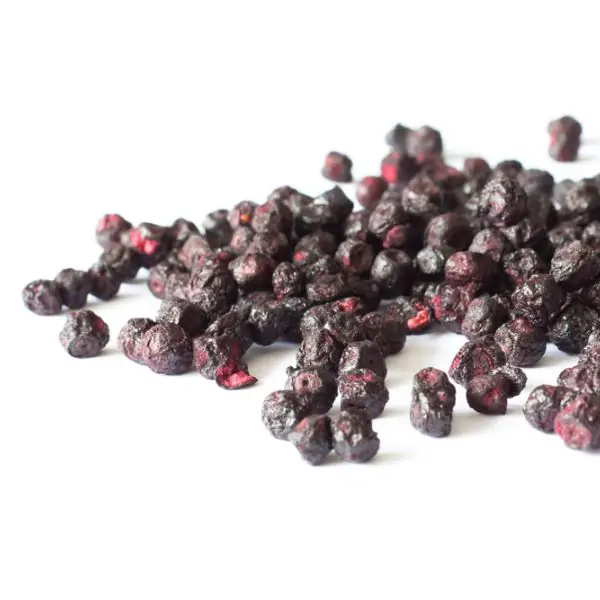
Line the dehydrator mesh tray with parchment or baking paper to keep them from being stained by the fruit juices. Dehydrated food tends to shrink due to the loss of water and moisture so lining the mesh tray with the baking or parchment paper prevents the blueberries from falling through the mesh.
Arrange blueberries on the paper-lined mesh tray, leaving a little space between each berry. Set the dehydrator to 135 degrees Fahrenheit and place the mesh tray with the blueberries inside.
Different factors play a role in determining how long you should dry the berries. These include the size of the berries, type of dehydrator, and even, the temperature and humidity levels in your home.
For example, if you live in a dry and cold climate, food typically dehydrates pretty fast. The way you process the skin, in the beginning, will also affect the dehydration time.
For instance, halved blueberries will take about 6 to 8 hours to dry. On the other hand, blanched fresh berries or thawed frozen berries will be somewhat syrupy, taking slightly longer, about 8 to 12 hours to dry.
As a general rule of thumb, you want to dry the berries for at least 8 to 12 hours, checking them every few hours until you are satisfied with the consistency.
Step 4: Check the Blueberries
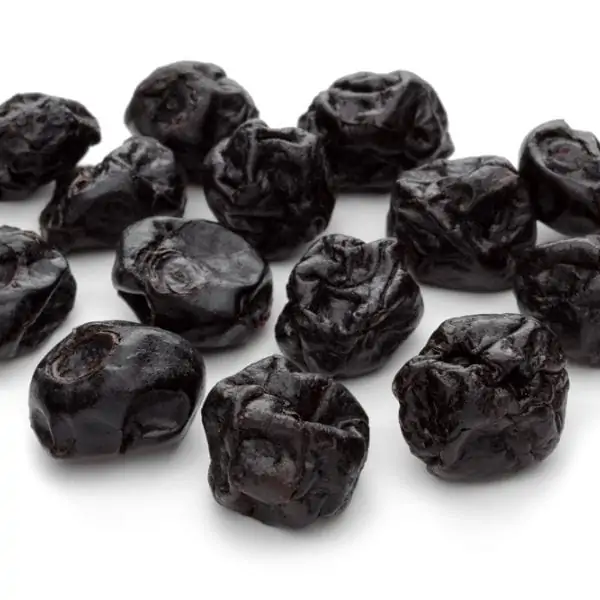
After 6 hours of dehydrating, check the berries to give you an idea of how quickly they dry, and then, rotate the trays. Continue to dehydrate them for another 2 hours or so.
Step 5: Remove the Blueberries from the Dehydrator
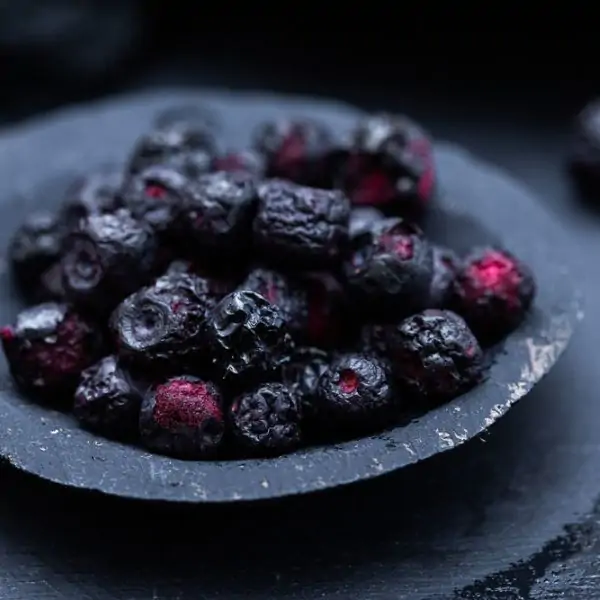
At this point, your blueberries should feel leathery and pliable with zero moisture or juices coming out when squeezed. Their high sugar content may also make them a little sticky – so don’t confuse this with moisture.
Remove the tray of blueberries from the dehydrator and let them cool for at least 2 hours. After two hours, the berries should be firmer and they should rattle the dehydrator tray when you shake them.
Step 6: Store Away the Blueberries
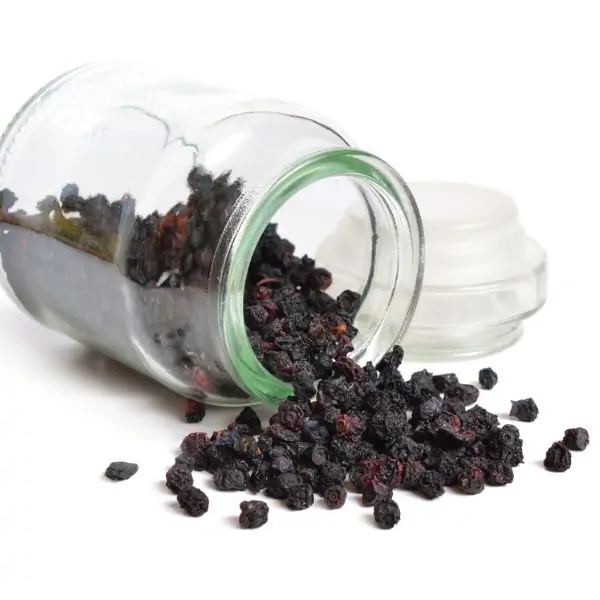
Transfer the blueberries into an airtight container, like a glass mason jar. You can use the blueberries anytime you want.
If you notice the blueberries are clumping together or notice any moisture build-up, you can always pop them back into the dehydrator.
Storing Dried Blueberries
In addition to proper dehydration, the storage of your blueberries plays a significant role in their shelf life.
When poorly stored, blueberries accumulate moisture and clump together, forcing them to go bad in no time. The first step to correctly storing your berries is to put them in an airtight container in a cool and dark place, like inside your kitchen cabinets.
Further, you want to condition the dried berries to balance out the moisture content (if any) in the container and berries. Even after hours of drying, some blueberries will have moisture left in them.
So, when stored in a single container together, the moisture escapes from these blueberries and transfers to much drier ones. This conditioning process takes about a week or so.
Now, here’s the right way to store your blueberry jar from the time you take them out of the dehydrator:
- After cooling, transfer the blueberries into a loosely sealed glass mason jar and let it sit on your countertop for at least a week.
- You want to shake the jar daily to check for any remaining moisture during this time. If you notice condensation on the jar walls, notice they clump too much, or get too soft, you want to redry them in the dehydrator until they feel firm.
- If you don’t notice any signs of moisture, tightly seal the jar and store it away in a cooler and dark space for long-term storage. Alternatively, you can vacuum seal the blueberries for even better preservation.
FAQ
What Is the Perfect Temperature to dehydrate Blueberries?
The ideal temperature for drying blueberries should be around 120 to 140 degrees Fahrenheit.
But, in addition to the temperature, you have to maintain sufficient airflow to adequately dry the berries. This is why you have to rotate the drying racks at least a few hours between the drying sessions.
Is It Possible To Over-Dehydrate Blueberries?
Not really, you cannot over-dehydrate most fruits or vegetables. The only issue you may have is drying your berries to the consistency you don’t want – producing dry and brittle berries or very soft berries.
For example, people prefer snacking on dried blueberries to be a little pliable and with some moisture left, making them soft and chewy. On the other hand, they don’t mind extremely dried blueberries for making blueberry powder or tea blends.
How Long Do Dehydrated Blueberries Last?
When dehydrated and stored correctly, dried blueberries can last you well over 6 to 12 months. However, during this time, you have to store them in an airtight container in a cool, dark place and ensure they are not exposed to any moisture in the air.
If you don’t want to bother with conditioning your berries every time, you can turn the dried berries into powder. Simply pop them into a coffee grinder or bullet blender, add them to an air-tight container with an anti-caking agent, like arrowroot, and store the powder in a cool, dark place for up to a year.
Blueberry powder is a great flavoring for yogurt, ice cream, frosting, baked goods, and even for adding color and flavor to dishes like pasta.
Conclusion
Learning how to dehydrate blueberries is pretty simple and when you master the technique can be quite rewarding. However, the best part is that blueberries are just as good, if not better than fresh ones.
In addition to retaining their rich nutrients and flavor, dried blueberries last you longer than fresh ones. So, you can ultimately enjoy them all year round.
Further, dehydrated blueberries offer you the versatility you wouldn’t enjoy with fresh blueberries. Whether you simply dry them, turn them into fruit leather, or a powder, you can use your dehydrated blueberries in a plethora of recipes, including baked goods, pasta, and even, flavored dairy drink.
Alternatively, you can just keep it simple by topping cereals, oatmeal, and trail mixes. Either way, it’s a pretty inexpensive and long-lasting way to enjoy your favorite fruits.





Donaldina is a home cook and writer who enjoys experimenting with different flavors. She loves to take her readers on a fun-packed, palate pleasing journey through different recipes. Along the way she recommends the best equipment and tools to prepare tasty meals. Enjoy the adventure!